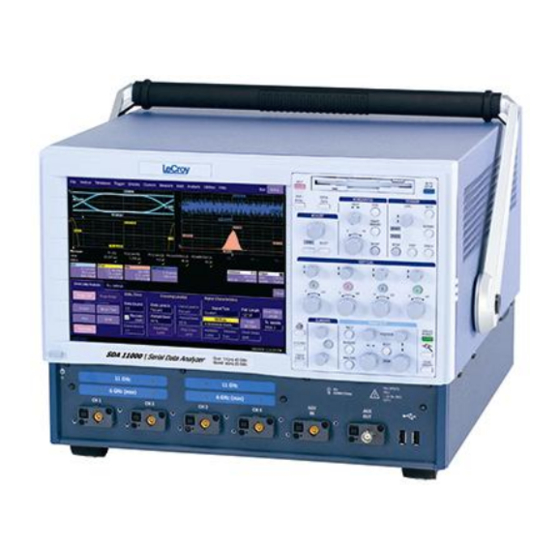
LeCroy SDA Manuals
Manuals and User Guides for LeCroy SDA. We have 1 LeCroy SDA manual available for free PDF download: Operator's Manual
LeCroy SDA Operator's Manual (397 pages)
SERIAL DATA ANALYZER
Brand: LeCroy
|
Category: Measuring Instruments
|
Size: 7 MB
Table of Contents
-
Introduction
18 -
-
Safety
42 -
Installation
53 -
-
Triggering
74-
-
Level77
-
-
-
-
-
Screen Saver101
-
XY Display105
-
XY Display Setup106
-
-
Save and Recall
106-
-
Saving Waveforms108
-
-
Disk Utilities110
-
-
Printing111
-
Printer Setup111
-
Printing112
-
-
Managing Files112
-
Track Views
114 -
Histograms
116-
-
DSO Process133
-
Parameter Buffer133
-
-
Histogram Peaks135
-
-
Cursors Setup137
-
Quick Display137
-
Full Setup137
-
-
Statistics141
-
Measure Modes141
-
Measure Gate145
-
Help Markers147
-
Waveform Math
178-
Math Made Easy179
-
-
Resampling180
-
-
Rescaling Setup182
-
Waveform Copy187
-
Waveform Sparser187
-
Interpolation188
-
Fast Wave Port188
-
Setup - Case 1190
-
Setup - Case 2190
-
Setup - Case 3190
-
Performance191
-
Performance195
-
Fft195
-
Why Use FFT195
-
Record Length198
-
FFT Algorithms199
-
Glossary200
-
FFT Setup203
-
-
Analysis
204-
-
Mask Tests205
-
Actions205
-
-
Utilities
210-
Status210
-
Hardcopy211
-
Aux Output212
-
Date & Time212
-
Options214
-
Preferences214
-
Audible Feedback214
-
Auto-Calibration214
-
Offset Control214
-
Delay Control215
-
Trigger Counter215
-
E-Mail216
-
-
Service217
-
-
Customization
218-
-
Introduction218
-
Solutions219
-
Examples219
-
What Is Excel224
-
What Is Mathcad224
-
What Is MATLAB224
-
What Is VBS224
-
-
Variable Names253
-
VBS Controls255
-
Summary of if257
-
Select Case258
-
While259
-
For259
-
-
-
Other VBS Words261
-
-
Functions262
-
Errors264
-
Error Handling266
-
Scripting Ideas267
-
-
Customdso
281 -
Labnotebook
293-
Preferences293
-
Hardcopy Setup294
-
E-Mail Setup294
-
-
-
Adding Previews305
-
-
-
-
SDA Capabilities306
-
SDM Capabilities307
-
-
Jitter Wizard309
-
SDA Basic Setup312
-
PLL Setup315
-
Summary317
-
Mask Test317
-
Eye Setup318
-
Mask Margin319
-
Testing320
-
-
Serial Trigger321
-
Jitter Setup325
-
SDA DBI Controls329
-
Pj Breakdown333
-
-
Effective Jitter333
-
MJSQ Jitter335
-
-
Bathtub Curve336
-
Jitter Filter337
-
TIE Histogram337
-
-
Adjust Rj345
-
-
-
-
Altncycle347
-
Htie to BER350
-
Slice2Persist353
-
-
SDA Theory
365-
Clock Recovery365
-
Eye Pattern368
-
-
Eye Amplitude370
-
Eye Height371
-
Eye Width371
-
Extinction Ratio371
-
Eye Crossing371
-
Average Power371
-
Q Factor or BER372
-
Eyeber372
-
-
Comparing Models382
-
Bit Error Rate383
-
Bit Error Map383
-
-
Q-Scale Theory386
-
Introduction386
-
-
Advertisement
Advertisement
